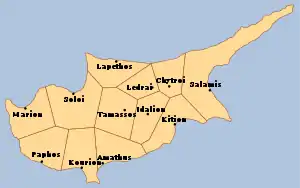Marion, Cyprus
Marion (Greek: Μάριον) was one of the Ten city-kingdoms of Cyprus. It was situated in the north-west of the island in the Akamas region, close to or under the present town of Polis.[1] Both Strabo and Pliny the Elder mention the city in their writings.
Μάριον | |
 Map showing the ancient city Kingdoms of Cyprus | |
 Shown within Cyprus | |
| Location | Cyprus |
|---|---|
| Region | Paphos District |
| Coordinates | 35.0375°N 32.4333°E |
History
See also Ancient history of Cyprus.



Marion was already inhabited at the end of the Neolithic and through the Chalcolithic period. It began to prosper from the Cypro-Archaic period onwards and became one of the most important ancient Cypriot city—kingdoms in the Cypro-Classical period with important commercial relations with the East Aegean islands, Attica and Corinth.
According to tradition, Athenian Acamas, son of Theseus, disembarked near Polis after the Trojan war and gave his name to the Cape of Akamas and the city of Akamantis, a legendary city which has never been found. Marion was probably founded by Acamas or a certain Marieus.
In Egypt at Medinet Habu in the temples of Ramesses III, there is a large 12th-century BC inscription which refers to Cypriot towns including Marion.
The Mycenaeans, or Achaeans settled in Cyprus between 1400 and 1100 BC and Marion was one of the city-kingdoms they founded.
The city became wealthy from the nearby copper and gold mines. It also served as an important trading port for both metal and timber. The foundations of the ancient harbour are visible to this day in the current port of Latchi.[2]
The first definite reference to Marion occurred in 449 BC when Kimon, the great Athenian general, freed the city from the Persians following the Battle of Salamis and in an attempt to re-establish Athenian supremacy in the Eastern Mediterranean.
Later, the ancient geographers spoke of the town as "Marion Hellenikon"—The Hellenic Marion. The Kingdom was rich in gold and copper ore, mined chiefly in the nearby Limni Mines. It was the natural wealth which led the city to a period of flourishing trade, especially with Athens, which in its turn, exported many Attic pots to Marion. Samples of this pottery can be viewed at the Polis Museum.
The battle for Cyprus between the successors of Alexander the Great, Antigonus and Ptolemy, led Marion to destruction in 312 BC. Ptolemy, who finally prevailed, laid waste the city whose last king (Stasioikos II) had taken the side of Antigonus, and transferred its inhabitants to Paphos. Later, another member of the Ptolemy dynasty, Philadelphus, founded a new city on the ruins of Marion in about 270 BC and gave it the name of his wife, Arsinoe.[3] The city, under its new name, prospered during the Hellenistic and Roman Ages.
Excavations

Archaeological excavations of the area were first undertaken by the Swedish Cyprus Expedition between 1927 and 1931.[5][6] They were followed by the Department of Antiquities of Cyprus, and since 1983 by the Princeton Cyprus Expedition.[7][8]
E. Linder and A. Raban carried out the only investigation of the remains of the harbour in 1971.[9]
However very few remains of the city have been found except for a temple to Zeus and Aphrodite and many tombs, some of whose contents can be seen in the Polis museum. The sanctuary of Zeus and Aphrodite dates from the 6th to 4th c. BC and was burnt and destroyed by the Ptolomies in 312 BC. The colossal terracotta statue found in it was probably a votive gift, and is the largest clay sculpture found in the island.
A fine marble kouros from Marion is now in the British Museum.[10]
References
- Childs, William (November 1997). "The Iron Age Kingdom of Marion". Bulletin of the American Schools of Oriental Research. The American Schools of Oriental Research. 308 (308): 37–48. doi:10.2307/1357408. JSTOR 1357408.
- "World of naval dockyards - the port of the kingdom of Marion". University of Cyprus. Retrieved 2007-03-05.
- http://www.perseus.tufts.edu/hopper/text?doc=Perseus:text:1999.04.0006:id=marion
- Strabo 14.683
- Gjerstad, E.; P. Dikaios (1949). "The Swedish Cyprus Expedition: Vol. IV". The Journal of Hellenic Studies. The Society for the Promotion of Hellenic Studies. 69: 124. doi:10.2307/629546. JSTOR 629546.
- E. Gjerstad, J. Lindros, E. Sjöqvist, A. Westholm, The Swedish Cyprus Expedition (Vols I-IV)
- Childs W.P., 1988 "First preliminary report on the excavations at Polis Chrysochous by Princeton University", Report of the Department of Antiquities of Cyprus (1988), Nicosia, 121-130
- Childs W.P., 1999 "Princeton excavations at Polis Chrysochous 1994-1997", Report of the Department of Antiquities of Cyprus (1999), Nicosia, p223-237
- Raban A., 1995 "The Heritage of Ancient Harbour Engineering in Cyprus and the Levant" in Karageorgis V. – D. Michaelides (ed.), Proceedings of the International Symposium Cyprus and the Sea, Nicosia, p165
- http://www.britishmuseum.org/research/collection_online/collection_object_details.aspx?objectId=464245&partId=1
